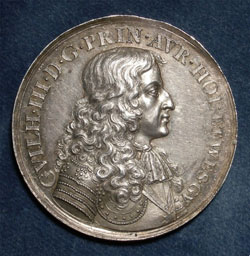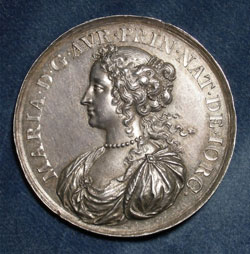

|
MARRIAGE OF WILLIAM III, PRINCE OF ORANGE, AND PRINCESS MARY |
|
|
|
|
|
CHEVALIER, Nicholas: France, 1677, Silver, 42 mm William III of England (1650-1702), also known as William II of Scotland and William III of Orange, was the son and only child of William II, Prince of Orange, and Mary, Princess Royal of England. A Dutch aristocrat, born in The Netherlands, he was the Prince of Orange from his birth, Stadtholder of the main provinces of the Dutch Republic from 1672, and King of England, Ireland, and Scotland from 1689, in each case until his death. Early on, many Protestants heralded him as a champion of their faith and hoped that he would be able to take the crown of England, as they were intensely fearful of Catholicism and the papacy. They also hoped to ally themselves with him against the French as he had a powerful army and a fleet four times larger than the famed Spanish Armada. To strengthen the position of The Netherlands against the French, William endeavored to marry his first cousin Mary, the daughter of James, Duke of York. Mary II (1662-1694), Queen of England, Scotland and Ireland was the elder daughter of James, Duke of York (later James II of England), and Anne Hyde. Despite her fatherís Catholicism, Mary was brought up a Protestant. In 1677, at the age of 15, Mary was married to her cousin William, the event commemorated by this medal. Although James would have liked to see his daughter marry the Catholic heir to the King of France, King Charles II (Jamesí brother) had insisted on making the match with their Protestant nephew to mollify the Protestants, who were extremely concerned about James' Catholicism. The marriage, ensuring that after James the crown would return to Protestant hands, was tremendously popular in England. During the Glorious Revolution (1688-1689), Mary and her husband William were invited to assume the English throne as joint monarchs, which they did as William and Mary, with James fleeing to France. LINK to contemporary account of the marriage (from bbc.co)
|
|